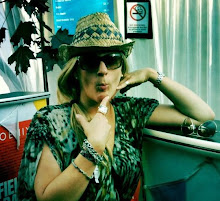Colour is a magnificent thing. I'm sure I've always taken it for granted, I mean why wouldn't I? Colour is everywhere. The luscious greens of summer trees, the burning orange and hot pink of a sunset, the brilliant reds of a poppy field, colours are endless and phenomenal. But perhaps what I take even more for granted is my ability to see all these glorious colours. Before I went to the
Colour and Vision exhibition at the
Natural History Museum I must confess that I'd never really stopped and thought about the fact that once upon a time life had no eyes. They evolved like the rest of us. In this exhibition you get to see how colour and vision are inextricably linked in evolution.
The first half of the exhibition is a rather fascinating journey from a simple monochrome life where shapes were minimal, movement limited and eyeless bodies were totally primitive, to a sudden explosion of life from an eyespot that evolved from the gloom. It was around 565 million years ago, during the Precambrian period that small, strange, gelatinous creatures crawled around in the mud, eyeless and sightless. Some organisms developed basic photoreceptors that allowed them to distinguish between light and dark. But essentially, with no eyes to see, colour was obsolete and life was slow and drab.
Then, over the next 500,000 years, a blink of an eye really in evolutionary terms, a simple photoreceptor had evolved into an intricate and complex image-forming eye. No longer were creatures dull, shapeless and bleak: suddenly they got a lot more complex and diverse. In the Cambrian era, as life progressed and became predatory, one needed to be able to see. The exhibition has an impressive array of fossils that are of the very first examples of animals with sight, mainly trilobites that had endless eyes on the end of stalks on their scaly backs.

I found this all to be fascinating but I have to say I was a little disappointed. I think I was expecting more of a multi-sensory, multimedia experience, given the main promotion image, title and tagline. The information was compelling but it was conveyed in a rather old-fashioned way, with lots of specimens in jars and things to read on the wall. That said, I took it all in and it all came across very succinctly. I was looking forward to more as I made my way through from the pre-visual colourless world into one with glorious technicolour.

I learnt that all vertebrates i.e. us and animals with backbones have camera-type eyes, receiving light through a single opening. Although, there is a range of what each species perceives as colour. Dogs for example only see in dichromatic vision: blue and green, whereas humans see red as well in trichromatic vision. At the beginning of the exhibition is a light installation showcasing our range of colour vision from reds to violet. Birds see even more than that as they see in tetrachromatic vision, which means that they can see UV and infrared.
Most arthropods have compound eyes made up of hundreds or thousands of tiny photoreceptors known as ommatidia. Molluscs have a large variety of eye types including both compound and camera-type eyes. Then there is a small group of species that have survived without the need for eyes such as coral and jellyfish.


Now that eyes were evolving, animals were developing shapes and colours that allowed them to elude newly sighted predators. Those that could hide and those that could spot prey were surviving and thriving, passing on their beneficial traits to future generations. You can literally see the race beginning between predator and prey and in this half of the exhibition you really begin to see how important colour is in the natural world. It not only makes the world a brighter place but it warns, it hides and it attracts. These three purposes of colour are the essence of life. To be successful, a species must survive, it must thrive and it must mate. Colour is the decoration that enables these behaviours.


There is a huge number of specimens in the exhibition, showcasing all of the complex ways in which animals exploit colour to warn predators, attract mates and create camouflage, from the iridescent blues and purples of a Morpho butterfly's wings to the bold fire engine red and black of a ladybird shell to the colourful swelling of a baboon's genitals.
The funny thing is, it is us humans that appreciate these incredible displays of colour, not the animals. It is humans that have come to view the colours of the world as beautiful and see it as an art form. As a species we are relatively plain. We have no stripes and no neon. We don't shimmer or shine. It falls on us to invent a relationship with colour and it is from our clothes, our jewellery, our homes and our culture that creates our identity and represents our feelings. I will always love and appreciate colour and I will continue to use it in every day of my life but it will never come to close to the real beauty of the colour of the natural world. And I'm so pleased I live in a world where people can see its extraordinariness.








0 Comments:
Post a Comment